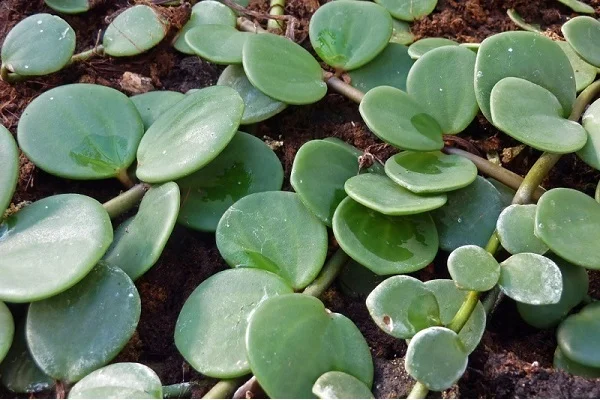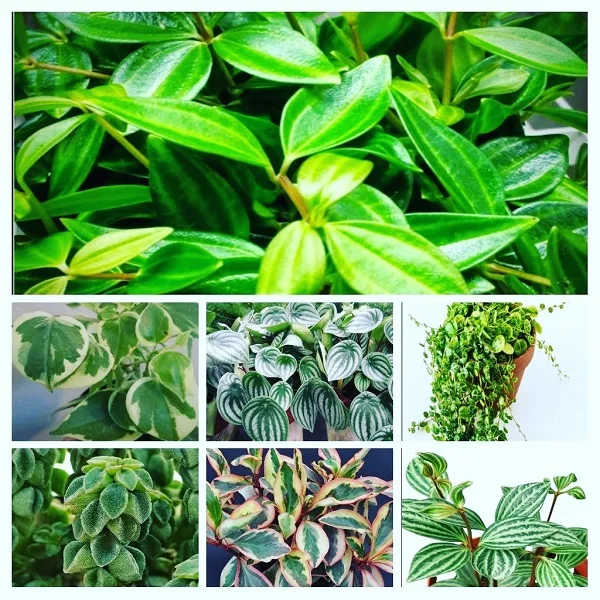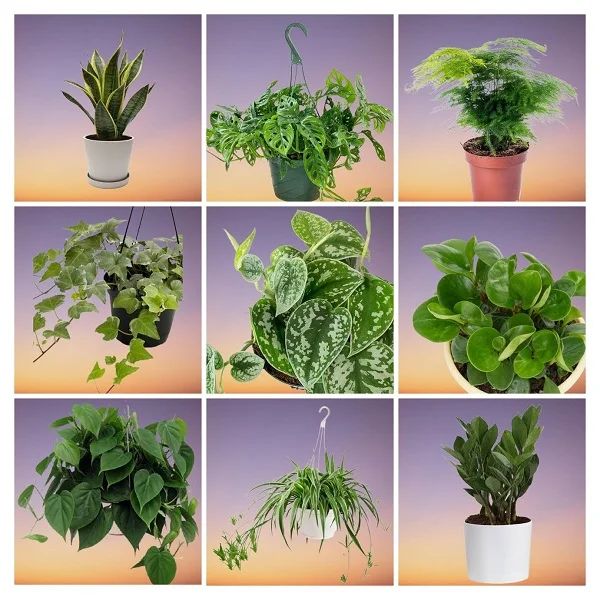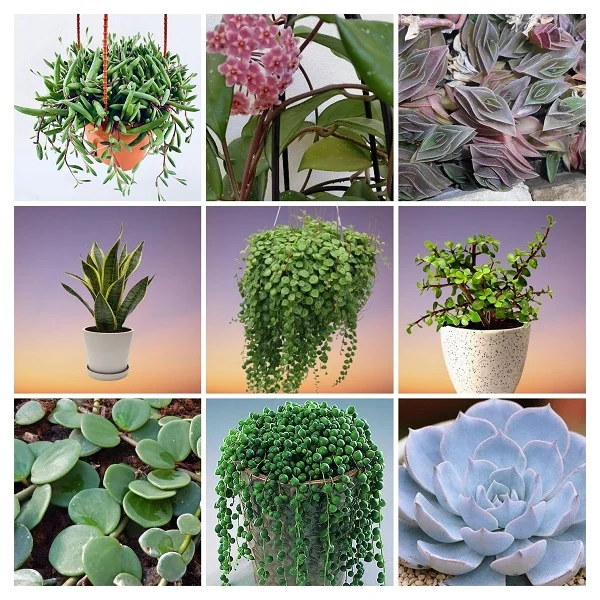How to Grow and Care for Peperomia rotundifolia (Trailing Jade) Indoors
Some links in this post may be affiliate links
Peperomia rotundifolia (Trailing Jade) thrives in medium to bright indirect light, warm and humid conditions and moderately moist, rich, well-drained soil coupled with monthly feeding in the growing season.
Trailing Jade also called Trailing Jade Peperomia, Creeping Jade Plant, Jade Necklace, Creeping Peperomia, Creeping Buttons and round Leaf Peperomia is among the popular trailing Peperomia varieties.
Trailing Jade Peperomia leaves are very small, thick and fleshy, succulent and button-like that may entwine and weave in and out of each other. The leaves have a rounded appearance and measure about an inch in diameter and are often used to propagate new plants. The stem consists of several small green leaves growing all along the stem on either side.
Creeping Jade Plant does well in a hanging basket, where the hanging shoots can beautifully cascade downwards making it one of the best succulent plants for hanging baskets.
Peperomia Trailing Jade flourishes when it is slightly pot-bound, therefore, take care not over pot it. Repot only when extremely root-bound into a pot only 1 size larger than the current one.

Botanical name: Peperomia rotundifolia
Family: Piperaceae
Common names: Trailing Jade, Trailing Jade Peperomia, Peperomia Trailing Jade Plant, Creeping Jade Plant, Jade Necklace, Creeping Peperomia, Creeping Buttons, Round-leaf Peperomia
Origin
Peperomia rotundifolia is native to the tropical rainforest of South America where it can be found growing on trees or crawling on rock cracks, rotten logs and the forest ground as well as it prefers moisture and shaded conditions.
Size
Trailing Jade is a compact, herbaceous, perennial plant which grows to a height of 12 inches only. This makes this plant ideal for the limited spaces in the home, office and other suitable spaces.
Flower
Peperomia rotundifolia flowers are unremarkable, rat-tail flower-heads made up of greeninsh flowers on an upright spike and appear above the foliage in summer. It is unlikely to flower when grown indoors.
Is Trailing Jade toxic?
No. Trailing Jade like other Peperomia Plants is non-toxic to humans and pets. Peperomia rotundifolia is non-toxic to cats, dogs and other pets.
Where to Buy
Would you like to add Trailing Jade to your collection? You may acquire these plants online from Etsy (Link to Etsy).
How do you care for Peperomia rotundifolia indoors?
Caring for Peperomia rotundifolia indoors, involves giving it medium to bright indirect light, average warmth of 15-260C, humidity of 55-65% and moderately moist, fertile, succulents potting mix coupled with monthly feeding during the growing season.
Trailing Jade care also requires regular pruning to keep it neat, minimize pest and disease infestations as well as rejuvenate growth. Repotting is only needed when the plant becomes extremely pot-bound. Keep reading for more details on these growing conditions and how to achieve them.

Watering
How often should I water Trailing Jade?
Water your Trailing Jade liberally in spring and summer and allow the top 2-3 inches of soil to dry out between waterings. Maintain the soil moderately moist and avoid overwatering to prevent rotting, yellowing and leaf drop.
Decrease the amount and frequency of watering in fall and winter to keep the soil barely moist as growth is minimal at this time. However, do not allow the soil to dry out completely to avoid wilting and drooping leaves.
Only water with water that is at room temperature to prevent cold shock which can lead to stunted growth and leaf drop. Use chlorine-free water like rain water to avoid browning of leaves.
Ensure that the pot has a drainage hole to prevent the soil from getting soggy as it can result in root-rot, yellowing and leaf drop.
Light Requirements
Does Trailing Jade need sunlight?
No. Trailing Jade prefers bright indirect light (dappled light). Keep it away from direct sunshine to prevent scorching of the leaves.
Make sure that the plant receives adequate light as too little light will result in leggy plants and loss of leaf color. If the natural lighting is not enough, you may use a grow light to supplement it.
Rotate the pot ocassionally to ensure that the plant receives light on all sides for even growth and also prevent leggy growth.
Temperature & Humidity
Peperomia Trailing Jade requires an average warmth of 15-260C; temperatures that are comfortable for you are ideal for this plant.
Keep Creeping Jade away from cold drafts coming from windy doors and windows to avoid sudden drops in temperature as they can lead to stunted growth, brown leaf tips and edges and leaf drop.
Hot drafts from stoves, air conditioning units and others can lead to extremely high temperatures which may result in reduced growth, wilting and drooping leaves, and leaf drop.
Jade Necklace thrives in a humidity of 55-65%. Too low humidity will result in brown, shrivelled leaves. To upscale humidity, set pot on a wet pebble tray or use a humidifier. Ensure that there is good air circulation to minimize fungal diseases.
You may also grow Trailing Jade in a closed terrarium where a high humidity can be maintained. Do not mist the leaves at it can encourage fungal diseases.
Fertilizer
Feed your Trailing Jade Peperomia with a balanced, liquid fertilizer every 4 weeks in spring and summer for a lush growth. Withhold feeding in fall and winter as growth is minimal and feeding at this time may lead to fertilizer burn.
Occasionally, flush out the salts from the soil by running a stream of water through the soil until it comes out through the drainage holes and repeat the process several times. Excess salts and chemicals in the soil may result in dry, shrivelled leaves.
Potting Soil
What kind of soil does Trailing Jade like?
Trailing Jade likes a potting soi that is acidic, loose, well-draining and rich in organic matter. The soil should be loose enough to allow water to drain out fast enough to prevent waterlogging. Cactus and succulents soils are ideal for this plant.
Repotting
Repot your Trailing Jade at the beginning of the growing season (spring to early summer), only when the plant has become pot-bound. It flourishes when the roots are confined.
Select a pot one size larger than the current one. Ascertain that the pot has a drainage hole to prevent waterlogging which can result in root-rot. Take a look at these succulents pots available on Amazon.
Pruning & Grooming
Pruning Trailing Jade Peperomia involves regular removal of dead foliage to maintain the plant neat and tidy as well as reduce pest and disease infestations.
To encourage a bushy, compact growth, regularly pinch of the growing tips at a point above a leaf node.
As the plant ages, it becomes straggly, therefore, cutback the stems during the growing season to rejuvenate growth.
Clean the leaves regularly by damp-wiping with a soft cloth to get rid of dust and also discourage pest and disease infestations.
Trailing Jade Propagation
Trailing Jade (Peperomia rotundifolia) propagation is done from leaf cuttings, from stem cuttings or by plant division in the beginning of the growing season when the plant is actively growing.
Learn how to propagate Trailing Jade (Peperomia rotundifolia).

Peperomia rotundifolia Problems & Solutions
Trailing Jade problems are yellow leaves, leggy stems, dropping leaves, drooping leaves, brown leaf tips, diseases and pests among others. Keep reading for more on these problems and how to fix them.
Yellow leaves
Why is my Trailing Jade turning yellow?
Some of the causes of yellowing on your Trailing Jade are inconsistent watering, soggy soil, nutrients deficiency or too little light.
How to fix it
Inconsistent watering: Water when the top 2-3 inches of soil dry out but never allow the soilball to dry out completely. Do not water on a schedule.
Soggy soil: Use a pot with a drainage hole and well-draining soil.
Nutrients deficiency: Feed the plant with a balanced, water-soluble fertilizer every 4 weeks in spring and summer.
Too little light: Place the plant in a brighter spot where it will receive bright indirect light or use a grow light is the natural light is not adequate.
Leggy stems
Why is my Trailing Jade Plant getting leggy?
Your Trailing Jade Plant is getting leggy due to too little light, overwatering or soggy soil.
How to fix it
Too little light: Position the plant in bright indirect light or instal a grow light if the natural lighting is not adequate.
Overwatering: Water only when the top 2-3 inches of soil dry out. Do not water on a schedule.
Soggy soil: Ensure that the pot has a drainage hole and the soil is well draining.
Dropping leaves
Some of the causes of leaf drop on Peperomia rotundifolia are incorrect watering, soggy soil, and insufficient light.
How to fix it
Incorrect watering: Water when the top 2-3 inches of soil dry out but never allow the soil to dry out completely. Do not water on a schedule.
Soggy soil: Pot the plant in a pot with a drainage hole and well-draining succulents soil.
Insufficient light: Place the plant in bright indirect light or use a grow light if the natural light is not enough.
Drooping leaves
The main causes of drooping leaves on Trailing Jade are direct sunlight, inconsistent watering, soggy soil, temperature stress, spider mites, and salts buildup.
How to fix it
Inconsistent watering: Water when the top 2-3 inches of soil feel dry out but do not allow the soil to dry out completely.
Soggy soil: Use a pot with a drainage hole and well-draining succulents soil.
Temperature stress: Keep the plant away from drafts coming from AC units, heat sources, windy doors and windows among others.
Spider mites infestations: Regularly inspect the plant for these pests and carry out timely control measures.
Salts buildup: Occasionally flush out the salts from the soil by running a stream of water through the soil until it comes out through the drainage holes.
Brown leaf tips and edges
Brown leaf tips and edges on Trailing Jade Plant are due to cold drafts, dry air and salts buildup.
How to fix it
Remove all the damaged leaves to keep the plant neat.
Cold drafts: Keep the plant away from cold drafts emanating from windy doors, drafty windows, AC units among others.
Dry air: Set the pot on wet pebble tray or use a humidifier to raise humidity. You may grow the plant in a well-lit bathroom and other humid places in the home.
Salts buildup: Flush out the salts from the soil every 1-2 months by running a stream of water through the soil until it comes out through the drainage holes.
Pests
Trailing Jade Plant is prone to scale insects, whiteflies, mealybugs and spider mites.
How to fix it
- Isolate the affected plant to prevent spread to other plants.
- Treat the infested plant with insecticidal soap as per the manufacturer's recommendations.
- Regularly, check between and underneath the leaves for these pests and carry out timely control measures.
- Maintain the plant well pruned to discourage the pest infestations.
Diseases
Trailing Jade Peperomia is prone to the following two diseases:
1. Leaf spot disease which is enhanced by poor air circulation coupled with damp conditions. It presents as brown, soft leaf spots.
How to fix it
- Isolate the affected plant and treat it with horticultural oil as per the manufacturer's instructions.
- Avoid wetting the leaves during watering to minimize the disease infestation; water from the bottom instead.
- Improve the air flow for the plant to discourage the disease.
2. Root-rot disease which is prevalent in soggy soil. It is characterized by wilted and discolored leaves and corky swellings under the leaves.
How to fix it
- Gently, slip the plant out of its pot and inspect the roots; brown-black mushy roots indicate root-rot.
- Cut away the rotten roots and treat the healthy roots with a copper-based fungicidal solution as indicated by the manufacturer.
- Repot the plant in fresh soil and a fresh pot.
- Use a pot with a drainage hole and well-draining soil to prevent it from getting soggy.
- Place the plant in bright light and stop watering for a few days to give the plant enough time to loss the excess water. After the dry period, resume routine care.
You liked it? Share on social media.
Related Content
Amazon Associates Disclosure
Homeplantsguide.com is a participant in the Amazon Services LLC Associates Program, an affiliate advertising program designed to provide a means for sites to earn advertising fees by advertising and linking to amazon.com.





